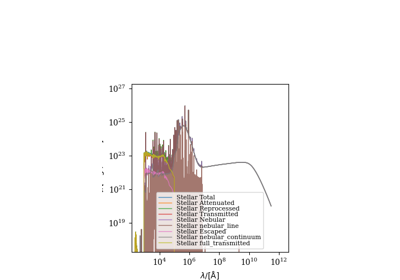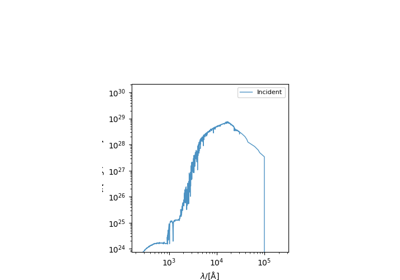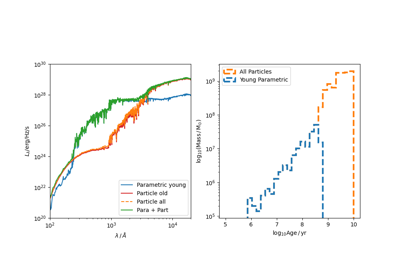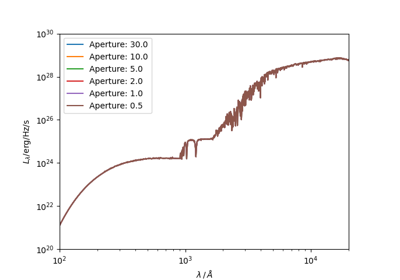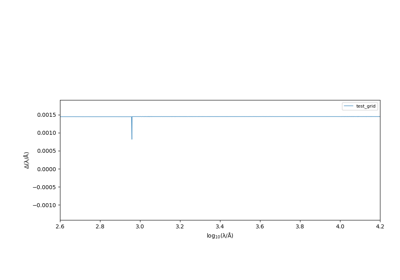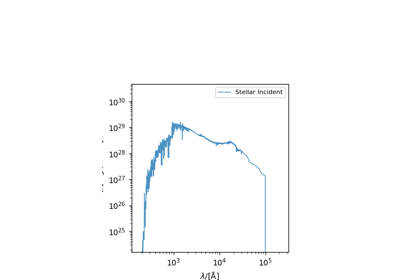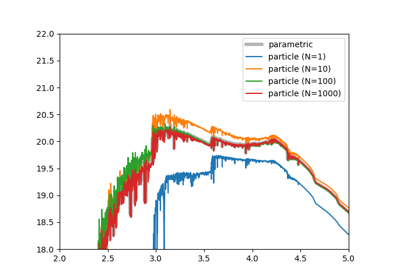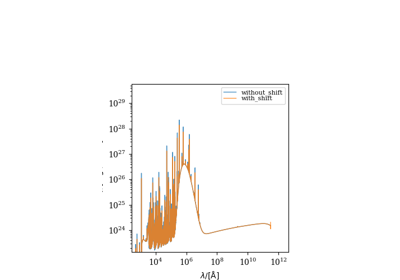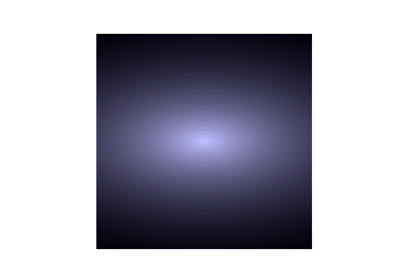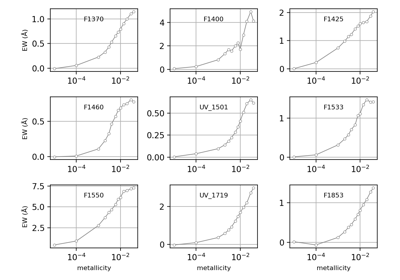synthesizer.emission_models.stellar.models¶
A submodule containing the definitions of common stellar emission models.
This module contains the definitions of commoon stellar emission models that can be used “out of the box” to generate spectra from components or as a foundation to work from when creating more complex models.
Example usage:
# Create a simple emission model
model = TotalEmission(
grid=grid,
dust_curve=dust_curve,
dust_emission_model=dust_emission_model,
fesc=0.0,
)
# Generate the spectra
spectra = stars.get_spectra(model)
Classes
- class synthesizer.emission_models.stellar.models.EmergentEmission(grid, dust_curve=None, apply_to=None, fesc='fesc', fesc_ly_alpha='fesc_ly_alpha', label='emergent', attenuated=None, escaped=None, **kwargs)[source]¶
An emission model that defines the emergent emission.
This defines combination of the attenuated and escaped emission components to produce the emergent emission.
This is a child of the EmissionModel class for a full description of the parameters see the EmissionModel class .
Examples using synthesizer.emission_models.stellar.models.EmergentEmission¶
- class synthesizer.emission_models.stellar.models.IncidentEmission(grid, label='incident', **kwargs)[source]¶
An emission model that extracts the incident radiation field.
This defines an extraction of key “incident” from SPS grid.
This is a child of the EmissionModel class for a full description of the parameters see the EmissionModel class.
Examples using synthesizer.emission_models.stellar.models.IncidentEmission¶
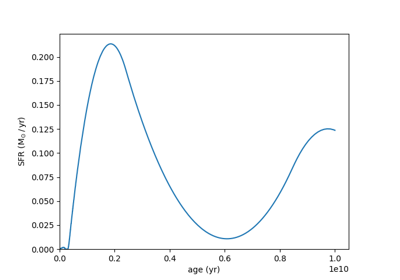
Demonstrate the dense basis approach for describing the SFZH
- class synthesizer.emission_models.stellar.models.IntrinsicEmission(grid, label='intrinsic', fesc_ly_alpha='fesc_ly_alpha', fesc='fesc', reprocessed=None, **kwargs)[source]¶
An emission model that defines the intrinsic emission.
This defines a combination of the reprocessed and escaped emission as long as we have an escape fraction greater than 0.0. Otherwise, it is identical to the reprocessed emission.
This is a child of the EmissionModel class for a full description of the parameters see the EmissionModel class .
- class synthesizer.emission_models.stellar.models.NebularContinuumEmission(grid, label='nebular_continuum', **kwargs)[source]¶
An emission model that extracts the nebular continuum emission.
This defines an extraction of key “nebular_continuum” from. SPS grid.
This is a child of the EmissionModel class for a full description of the parameters see the EmissionModel class .
- class synthesizer.emission_models.stellar.models.NebularEmission(grid, label='nebular', fesc_ly_alpha='fesc_ly_alpha', nebular_line=None, nebular_continuum=None, **kwargs)[source]¶
An emission model that combines the nebular emissions.
This defines a combination of the nebular continuum and line emission components.
This is a child of the EmissionModel class for a full description of the parameters see the EmissionModel class .
Examples using synthesizer.emission_models.stellar.models.NebularEmission¶
- class synthesizer.emission_models.stellar.models.NebularLineEmission(grid, label='nebular_line', fesc_ly_alpha='fesc_ly_alpha', fesc='fesc', **kwargs)[source]¶
An emission model for the nebular line emission.
This defines the luminosity contribution of the lines to the total nebular output.
This is a child of the EmissionModel class; for a full description of the parameters see the EmissionModel class.
- class synthesizer.emission_models.stellar.models.ReprocessedEmission(grid, label='reprocessed', fesc='fesc', fesc_ly_alpha='fesc_ly_alpha', nebular=None, transmitted=None, **kwargs)[source]¶
An emission model that combines the reprocessed emission.
This defines a combination of the nebular and transmitted components.
This is a child of the EmissionModel class for a full description of the parameters see the EmissionModel class .
Examples using synthesizer.emission_models.stellar.models.ReprocessedEmission¶
- class synthesizer.emission_models.stellar.models.TotalEmission(grid, dust_curve, dust_emission_model=None, fesc='fesc', fesc_ly_alpha='fesc_ly_alpha', label='total', **kwargs)[source]¶
An emission model that defines the total emission.
This is a wrapper around the TotalEmissionWithEscape and TotalEmissionNoEscape models. It will choose the appropriate model based on the inputs.
This is a child of the EmissionModel class for a full description of the parameters see the EmissionModel class .
Examples using synthesizer.emission_models.stellar.models.TotalEmission¶
- class synthesizer.emission_models.stellar.models.TotalEmissionNoEscapedNoDust(grid, dust_curve, label='attenuated', fesc_ly_alpha='fesc_ly_alpha', **kwargs)[source]¶
An emission model that defines total emission without dust emission.
When no escape fraction is applied and no dust emission is included the total emission is simply the attenuated emission. This is just a helpful wrapper around that case.
This is a child of the EmissionModel class for a full description of the parameters see the EmissionModel class .
- class synthesizer.emission_models.stellar.models.TotalEmissionNoEscapedWithDust(grid, dust_curve, dust_emission_model, fesc_ly_alpha='fesc_ly_alpha', label='total', **kwargs)[source]¶
An emission model that defines total emission.
This defines the combination of the emergent and dust emission components to produce the total emission.
This is a child of the EmissionModel class for a full description of the parameters see the EmissionModel class .
- class synthesizer.emission_models.stellar.models.TotalEmissionWithEscapedNoDust(grid, dust_curve, fesc='fesc', fesc_ly_alpha='fesc_ly_alpha', label='total', **kwargs)[source]¶
An emission model that defines total emission with an escape fraction.
When there is an escape fraction applied but no dust emission is included the total emission is simply the emergent emission. This is just a helpful wrapper around that case.
This is a child of the EmissionModel class for a full description of the parameters see the EmissionModel class .
- class synthesizer.emission_models.stellar.models.TotalEmissionWithEscapedWithDust(grid, dust_curve, dust_emission_model, label='total', fesc='fesc', fesc_ly_alpha='fesc_ly_alpha', **kwargs)[source]¶
An emission model that defines total emission with an escape fraction.
This defines the combination of the emergent and dust emission components to produce the total emission.
This is a child of the EmissionModel class for a full description of the parameters see the EmissionModel class .
- class synthesizer.emission_models.stellar.models.TransmittedEmission(grid, label='transmitted', fesc='fesc', incident=None, related_models=(), escaped_label='escaped', **kwargs)[source]¶
An emission model that extracts the transmitted radiation field.
This is a wrapper around the TransmittedEmissionWithEscaped model and the TransmittedEmissionNoEscaped model. It will choose the appropriate model based on the inputs.
This is a child of the EmissionModel class for a full description of the parameters see the EmissionModel class.
Examples using synthesizer.emission_models.stellar.models.TransmittedEmission¶
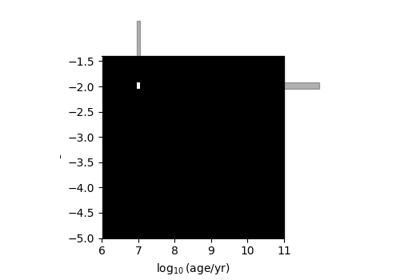
Compare Single star particle to instantaneous SFZH
- class synthesizer.emission_models.stellar.models.TransmittedEmissionNoEscaped(grid, label='transmitted', **kwargs)[source]¶
An emission model that extracts the transmitted radiation field.
This defines an extraction of the key “transmitted” from. SPS grid.
This is a child of the EmissionModel class for a full description of the parameters see the EmissionModel class.
- class synthesizer.emission_models.stellar.models.TransmittedEmissionWithEscaped(grid, label='transmitted', fesc='fesc', related_models=(), incident=None, escaped_label='escaped', **kwargs)[source]¶
An emission model that extracts the transmitted radiation field.
- This defines 3 models:
An extraction of the key “transmitted” from SPS grid.
A transformed emission, for the transmitted radiation field accounting for the escape fraction.
A transformed emission, for the escaped radiation field accounting for the escape fraction.
If fesc = 0.0 then there will only be the extraction model.
This is a child of the EmissionModel class for a full description of the parameters see the EmissionModel class.
Examples using synthesizer.emission_models.stellar.models.TransmittedEmissionWithEscaped¶

Compare Single star particle to instantaneous SFZH
